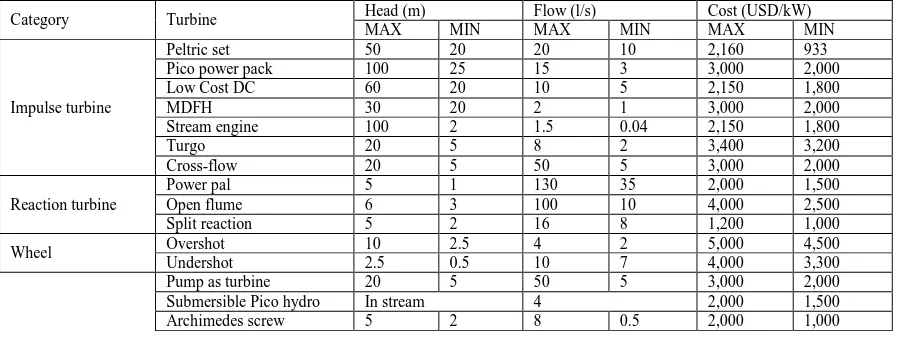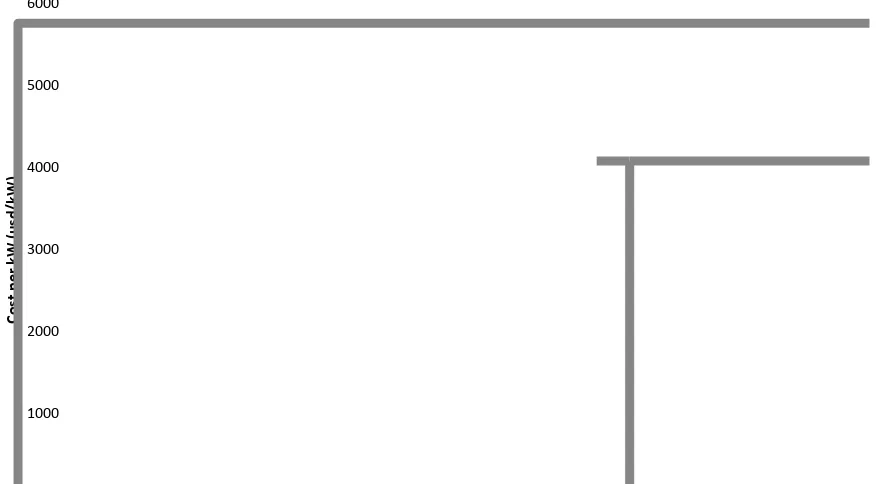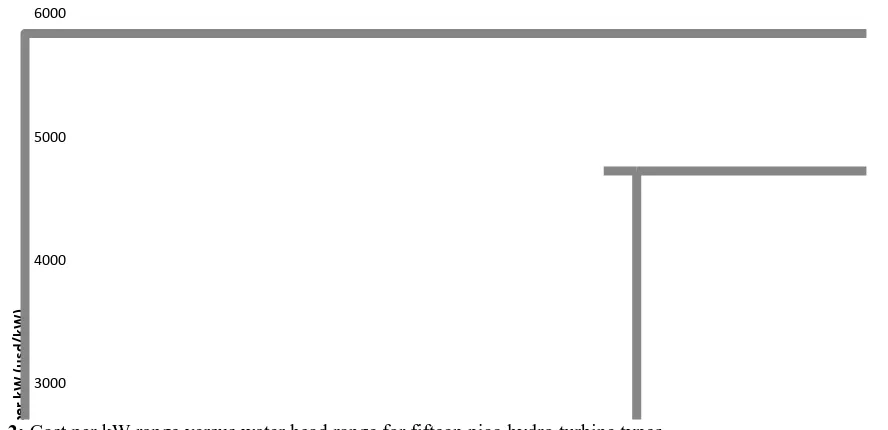AENSI Journals
Advances in Environmental Biology
ISSN-1995-0756 EISSN-1998-1066Journal home page: http://www.aensiweb.com/AEB/
Corresponding Author: Mohd Farriz Basar, Faculty of Engineering Technology, Universiti Teknikal Malaysia Melaka, 76100 Durian Tunggal, Melaka, Malaysia.
Phone (606-2346588) E-mail: [email protected].
Cost Analysis of Pico hydro Turbine for Power Production
1Mohd Farriz Basar, 1Razali Sapiee, 1Syukri Rahman, 1Zulfiqah Hamdan, 1Shuhada Borhan, 2Kamaruzzaman Sopian
1
Faculty of Engineering Technology, Universiti Teknikal Malaysia Melaka, 76100 Durian Tunggal, Melaka, Malaysia.
2Solar Energy Research Institute, Universiti Kebangsaan Malaysia, 43600 Bangi, Selangor, Malaysia.
A R T I C L E I N F O A B S T R A C T
Background: Turbine played a significant role in the hydro system and a determinant of the quality and quantity production of electric power in each power system. Objective: In this paper, several types of pico hydro water turbines are reviewed and compared. The water head, water flow rate and the current market price are the basic aspects considered in discussing the turbines selection. Results: Most of the small hydro turbines currently available are mostly suitable for low head high flow or high head low flow condition. By the assumption that the percentage of turbine efficiency is consistent for all conditions of water resources, the ability of water turbine to produce high output during low head low flow condition is low. Conclusion: The effectiveness of a turbine does not only depends on the productivity of the turbine to generate output power, but must also be seen in terms of cost and economical investment.
© 2014 AENSI Publisher All rights reserved. To Cite This Article: Mohd Farriz Basar, Razali Sapiee, Syukri Rahman, Shuhada Borhan, Zulfiqah Hamdan, Kamaruzzaman Sopian., Cost Analysis of Pico hydro Turbine for Power Production. Adv. Environ. Biol., 8(14), 147-151, 2014
INTRODUCTION
The stability of the environment should not be affected by the power generation system. For example, the massive constructions of large dams have changed the earth landscape, destroying the wildlife habitat and contributing to the global warming [1]. From this aspect, the large hydro power is not categorized as renewable energy [2]. In contrary, small-hydro (i.e. micro & pico) which is insulated with the negative effects is declared as clean technologies. Pico hydro can also be seen as an alternative to generate power and is more beneficial than the other small-scale renewable or conventional energy. Based on a few aspects that the system may offer, people start to explore the system to get the benefit from it. As a result, it boosts the technology development which is currently not fully explored by some of the researchers [3]. Besides, the demand for pico hydro in the market shows that it is a favorable solution in the generation of electricity. Lahimer et al [4] reported that the electricity demand is increasing rapidly over the years and one of the ways to secure access to electricity for a low income community is by choosing the right technology by considering a few important factors. The concept has met the electricity basic needs for the small community even though the capability to generate power is less than 5kW [5]. However, as for the cost per kilowatt output of the commercial turbine is considerably high, more research need to be done to overcome this problem [6-7]. For extremely low head water condition, pico hydro is the most cost-effective renewable energy system. [8]. This paper analyzes the market prices of water turbine which is basically used in the existing pico hydro power generation. It is evaluated based on the turbine costs in reference to the water head and water flow rate of water resources.
Turbine Ability:
Turbine converts the gravitational potential energy which is under the force of gravity to become kinetic energy when the water turbines are spanned by water rushing down and at the same time it simultaneously drives the electric generators. General output power of the turbine can be calculated by mathematical calculation as expressed below:
where: PT= Turbine power output (W) g = Gravitational acceleration (m/s2) = Efficiency percentage of energy transferred H = Water head (m)
= Density of water (kg/m3 or kg/l) Q = Flow discharge (l/s)
Based on equation (1), water head (H) and water flow rate (Q) are the key parameters in determining the reliability of a turbine to produce power output. Generally, the parameter is either high, low or both parameters are low. The water turbines available in the market today are mostly suitable only for the high head low flow application or vice versa [1, 3, 5-6]. Anyhow, up to now, there are still a few numbers of turbines that are capable to operate efficiently in low head low flow rate condition [4, 7]. Referring to equation (1) again, by assuming that the percentage of turbine efficiency is the same for all conditions of the water resources, the ability of the water turbine to produce high output during low head low flow condition is unfavorable. Regardless of how it operates, the effectiveness of the turbine does not only depend on the productivity in generating power output but also must be practical in terms of cost and economical investment.
In the early stages of a project, a Pugh Matrix can be applied for evaluation and selection of a turbine [9]. In any case, this approach is relatively subjective with less emphasize on the turbine design analysis. Williamson et al [10] reported that the most appropriate assessment and selection of pico hydro turbine can be acquired by using quantitative and qualitative analysis. The selection criteria are based on the requirement set by the end user. However, multi-criteria analysis presented does not discuss in detail about the importance of taking into account the financial implications in the selecting process of the turbine.
Turbine Cost:
The cost to make a turbine plays an important role in the effective cost of a pico hydro system. The turbine designs are classified into two types according to design which are the simple and complex designs. The complex design usually requires high expertise to make a turbine as it involves attentive care in terms of the fineness of blade profile, size, blade angle and etc. [2, 7, 10]. However, the complex design does not determine the ability of the turbine. Low-cost turbine units are usually made in China and other Asians countries [11]. The prices are reasonable compared to the one from the Western countries. The higher the output power required by the consumer, the higher the cost of the turbine. Medium and low head unit are much cheaper than high head unit for the same power output [11]. This is due to high demand as well as the manufacturers producing it in bulk, thus reducing the per unit price.
Table 1 : Comparison of head, flow and cost for fifteen types of pico hydro turbine.
Category Turbine Head (m) Flow (l/s) Cost (USD/kW) 5kW. It compares fifteen types of pico hydro turbines with maximum and minimum range of the water head (H), flow rate of water (Q) and the cost per kW. The data collected is based on the current market price which has been identified after conducting surveys [12-20]. Each turbine has different prices depending on two important parameters; water head and flow rate.
The fifteen pico hydro turbines listed in Table 1 are then compared according to their cost range to produce 1 kW power against the range of flow rate. Fig. 1 shows the comparison of cost per kW range against the water flow rate range. It is plotted based on the data range; cost per kW range and flow rate range shown in Table 1 for each pico hydro turbine types which form a rectangular shape for each type. From the cost aspects, split reaction has the lowest cost range from USD1,000 to USD1,200 per kW power and the highest market price is open flume which ranges between USD2,500 to USD4,500 per kW power. Based on the graph, the average flow rate falls in the range from 0.04 to 20 liter per second and the cost average lies between the ranges of USD1,800 to USD3,000. Referring to Fig. 1, by taking into consideration the cost per kW average and flow rate average which falls into more than one rectangular areas, it can be summarized that power pal is the best choice to be used as pico hydro turbine as the market price is quite low and the range of the flow rate is wider compared to the other turbines.
0 1000 2000 3000 4000 5000 6000
C
o
st
p
e
r
kW
(
u
sd
/kW
)
Fig. 2: Cost per kW range versus flow rate range for fifteen pico hydro turbine types.
3000
Fig. 2: Cost per kW range versus water head range for fifteen pico hydro turbine types.
Based on Fig. 2 before, the turbine with low head and low flow rate requirements has low market price. Besides, most of the reaction type turbines have low market prices compared to the other type of turbines. Non complex turbine design and the type of materials used in fabrication are the contributing factors why the type of turbines has low market prices. The turbine size factor also plays a role in determining the cost of turbine. The graph shown in Fig. 2 also shows that the wider the head range, the low the flow rate of the turbine design and vice versa. The highest cost for the turbine design is the open flume turbine and the lowest cost would be the split reaction, power pal and peltric set. Theoretically, split reaction and power pal falls under the reaction turbine types, so as a conclusion, the reaction turbine types has the lowest cost.
Conclusion:
The selection of proper turbine can be based on the suitability of water resources. In addition, the financial resources are very important. Most turbines available are from the impulse type, followed by reaction turbines. As a whole, the cost per kW is between USD2,000 to USD3,000. At this cost, the range of water head is from 5 meters to 50 meters and the water flow rate is between 2 l/s to 50 l/s. Interestingly, split reaction, overshot, undershot, submersible and Archimedes screw are the turbines that are capable to operate at low head low flow water condition. In addition, these turbines offer low cost per kW except for overshot and undershot waterwheel turbine. With the capability of pico hydro system in generating output power up to 5 kW, the cost per kW can be said to be the same for all types of turbines. Not being similar with the water head and flow rate, the ranges for both are too large and notable among the fifteen types of pico turbines available in the market.
REFERENCES
[1] Basar, M.F., A. Ahmad, N. Hasim, and K. Sopian, 2011. "Introduction to the pico hydro power and the status of implementation in Malaysia." In Research and Development (SCOReD), 2011 IEEE Student Conference on, pp: 283-288.
[2] Basar, M.F. and M.M. Othman, (n.d.). An Overview of the Key Components in the Pico Hydro Power Generation System Faculty of Engineering Technology, pp: 206-213.
[3] Smith, N.P.A., P. Maher and A.A. Williams, 2000."Strategies for sustainable and cost-effective village electrification using Pico hydro power." In World renewable energy congress, pp: 1490-1495.
[4] Lahimer, A.A., M.A. Alghoul, F. Yousif, T.M. Razykov, N. Amin and K. Sopian, 2013. Research and development aspects on decentralized electrification options for rural household. Renewable and Sustainable Energy Reviews, 24, 314–324. doi:10.1016/j.rser.2013.03.057
[5] Zainuddin, H., A. Khamis, M.S. Yahaya, M. Basar, J.M. Lazi and Z. Ibrahim, 2009. Investigation on the performance of pico hydro generation system using consuming water distributed to houses. 2009 1st International Conference on the Developements in Renewable Energy Technology (ICDRET), 1–4. doi:10.1109/ICDRET.2009.5454216
[7] Othman, M.M., J.A. Razak, R. Ayob and M.A. Rosli, 2011. Development of Model System for Cost-Effective Pico hydro Turbine, (June), 1-3.
[8] Date, A., and A. Akbarzadeh, 2010. Design and analysis of a split reaction water turbine. Renewable Energy, 35(9): 1947-1955. doi:10.1016/j.renene.2010.01.023
[9] Otto, K., K. Wood, 2001. Product design. 1st ed. New Jersey: Prentice Hall.
[10]Williamson, S.J., B.H. Stark and J.D. Booker, 2014. "Low head pico hydro turbine selection using a multi-criteria analysis." Renewable Energy, 61: 43-50.
[11]Lahimer, A.A., M.A. Alghoul, K. Sopian, Nowshad Amin, Nilofar Asim, and M.I. Fadhel, 2012. "Research and development aspects of pico hydro power." Renewable and Sustainable Energy Reviews, 16(8): 5861-5878.
[12]Cd, M., 2010. UNDERWATER 100 ( UW 100 ) Manufactured by Ampair ® Operation Installation & Maintenance Manual, pp: 1-20.
[13]Denchfield, S., R. Marth and B. Shelmerdine, (n.d.). STREAM WHEELS FOR APPLICATIONS IN SHALLOW AND DEEP, (1), 1–9.
[14]Date, A., A. Date, A. Akbarzadeh and F. Alam, 2012. Examining the Potential of Split Reaction Water Turbine for Ultra-Low Head Hydro Resources. Procedia Engineering, 49: 197-204. doi:10.1016/j.proeng.2012.10.128
[15]Energy, R., 1983. WATER WHEELS AS A POWER SOURCE Dr. Gerald Müller, pp: 1-9.
[16]Meier, B.T. and G. Fischer, 2011. Assessment of the Pico and Micro-Hydropower Market in Rwanda, (December).
[17]Mhg-, L.H. and L.H. Mhg, (n.d.). Use and Care Instructions for your new Low Head Micro-hydroelectric Generator, 1-14.
[18]Williamson, S.J., B.H. Stark and J.D. Booker, 2013. Performance of a low-head pico hydro Turgo turbine. Applied Energy, 102: 1114-1126. doi:10.1016/j.apenergy.2012.06.029
[19]Motwani, K.H., S.V. Jain and R.N. Patel, 2013. Cost Analysis of Pump as Turbine for Pico Hydropower
Plants – A Case Study. Procedia Engineering, 51(NUiCONE 2012), 721-726.
doi:10.1016/j.proeng.2013.01.103
[20]Maher, P., and N. Smith, 1999. Power Pack : a new design for pico hydro, (october).


